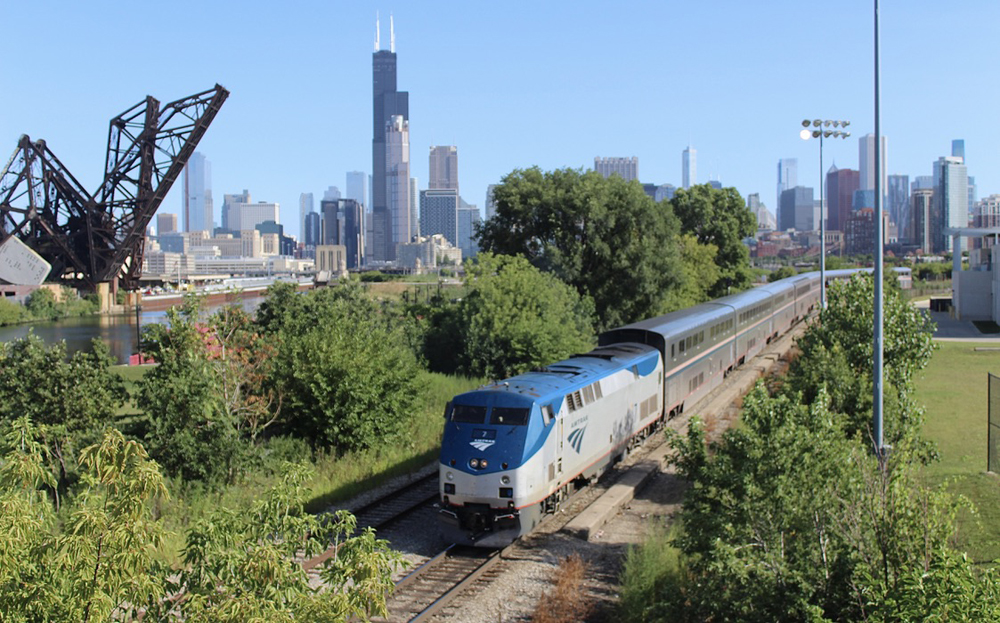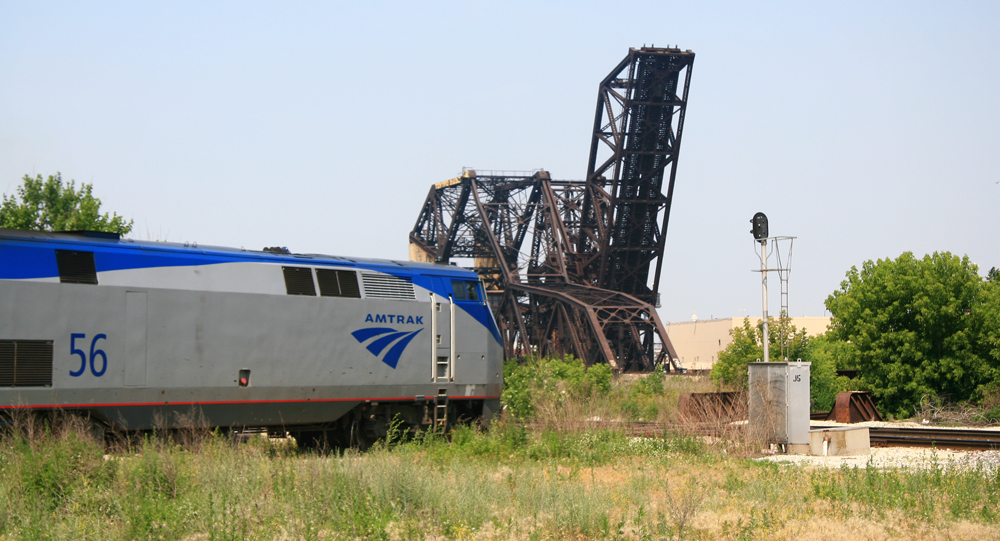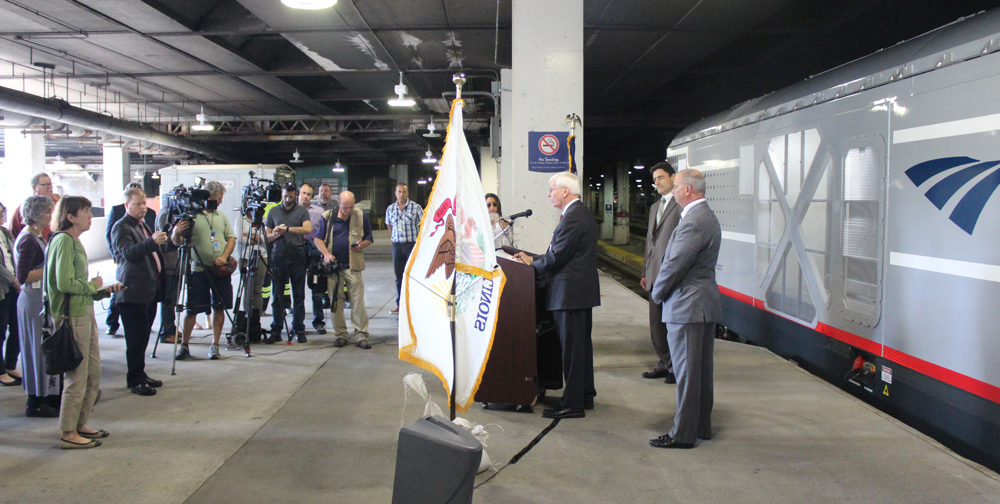
CHICAGO — Amtrak is seeking more than $200 million in federal funding, along with money from state and local sources, in an attempt to fix a series of long-standing deficiencies, capacity limitations, and how trains from the south and east enter Chicago.
The passenger operator is competing for a portion of $5 billion available between 2022 and 2026 under the National Infrastructure Project Assistance, or Mega Program. It seeks $251.1 million in federal grants, which it would match with $83.7 million from its annual appropriation and an equal amount from a combination of partners including transportation departments of Illinois, Michigan, and the City of Chicago; Metra; and Cook County, Ill.
If Amtrak is among applicants selected by the U.S. Department of Transportation to receive funding from the Mega program, the total of $418.5 million from all sources would fund these interconnected projects:
Direct access from the St. Charles Airline to Chicago Union Station: Estimated cost, $146.5 million
City of New Orleans and Illini/Saluki trains using Canadian National’s former Illinois Central grade-separated lakefront route from the south currently execute a time-consuming back-up move to get to or from tracks leading to Union Station. That’s because the current connections face south to Norfolk Southern’s Chicago-Toledo route or west to BNSF Railway’s three-track main after crossing the Chicago River’s South Branch on an elderly drawbridge, which has been out of service in the raised position for more than two years. Its BNSF, CN, and Union Pacific owners have not prioritized repairs because other routes are available.
Trains News Wire has learned that high-level engineering design for a track descending from the elevated Air Line to a north-facing connection to Union Station was studied in 2009 when Amtrak learned economic stimulus funds might be available.
“There were some grade and curvature concerns, but they were comparable to those of North River tunnels under the Hudson River in New York and the BNSF flyover out of Los Angeles,” says a source familiar with previous Chicago terminal improvement initiatives. A more recent study completed in 2021, referenced in the grant application, shows a single track descending from the Air Line between the BNSF and Amtrak mains.
The estimated cost includes preliminary engineering, environmental compliance, final design, and construction. Building the connection will also likely require repairing the drawbridge and leasing or purchasing the Air Line.
Property acquisition for storage and displaced service functions: $29 million
Though not specified in the “project narrative,” a letter urging support of prospective stakeholders obtained by News Wire identified the land as UP’s Canal Street yard.
Rebuilding a connection between the Airline and Metra’s Rock Island District, and a new station platform in Joliet, Ill.: $69.9 million plus $21.8 million in Joliet

The preferred route for St. Louis-bound trains between Chicago and Joliet blessed by the Federal Railroad Administration is Metra’s Rock Island District, not the existing, delay-prone CN tracks used by the Texas Eagle and Lincoln Service, as well as Metra’s low-frequency Heritage Corridor. Detouring Amtrak trains periodically have used the existing connecting track at 16th Street Tower, but its tight radius limits speeds to 5 mph. A new connection would increase that to 25 mph. The new platform in Joliet would be necessary given the new location where Amtrak trains would arrive and depart.
Chicago Union Station mail platform “reactivation:” $35 million

The easternmost tracks of Union Station’s south concourse once facilitated the loading and unloading of bulk mail destined to or delivered from the Chicago Post Office building above. Since the end of Amtrak’s mail and express initiative in 2005, they have been used only for passenger car or maintenance equipment storage; idle Siemens Venture cars now reside there.
The platforms are chipped and need refurbishing with Americans with Disabilities Act-compliant markings and lighting. Their rehabilitation is especially significant because two of the platforms serve through tracks that can be utilized by Wisconsin trains leaving from the north concourse. At least initially, Amtrak personnel will escort travelers across tracks 28 and 30 to the three platforms slated for improvement.
Union Station trainshed ventilation, concourse, and platform capacity improvements: $97.3 million
Amtrak has attempted to get this basket of overdue rehabilitation projects funded with previous grant applications, but is folding it into the “Mega” umbrella because the additional capacity created by reactivating mail platforms would allow other parts fo the station to be shut down.
Double track from Niles to Glenwood, Mich.: $20 million
A total of 16 miles of new second main would link and extend existing passing sidings from Niles through and beyond Dowagiac, Mich., thereby reducing delays resulting when passenger-train meets don’t occur as scheduled. This is common for Wolverine and Blue Water trains as a result of freight train interference west of Porter, Ind., on Norfolk Southern and east of Dearborn or Battle Creek, Mich., on Canadian National. As with the two Airline connection projects, the Joliet platform, and the Union Station improvements, the cost estimate includes preliminary engineeering, environmental compliance, final design, and construction.
Acquiring the CN’s Lakefront line as far as Kensington, and possible use of South Shore to Michigan City and South Bend, Ind: Proposed, no cost estimate
These investments are estimated at $418.5 million. But buried in the description of the St. Charles Airline acquisition is this statement, “Just as importantly, it will provide a means by which Michigan and East Coast trains can link to the minimally used CN Lakefront Line to Chicago’s far South Side. The trains can ultimately switch to passenger-friendly South Shore Railroad trackage (at 115th Street/Kensington) to reach the Amtrak-owned infrastructure in Michigan City, Ind.”
A letter sent to potential stakeholders went further. “By acquiring this critical, but currently underutilized 13-mile segment of the CN Lakefront line, Amtrak would be in control of Illinois, Michigan and East Coast trains … this would eliminate all usage of the heavily-congested Norfolk Southern Chicago Line.”
It is premature to assume such a transaction might occur, given that no formal negotiations have taken place with Canadian National or the South Shore’s parent, the Northern Indiana Commuter Transportation District, according to Amtrak spokesman Marc Magliari. He did note, however, that CN in the past has expressed interest in a potential sale of this line.
The Lake Shore Limited and Capitol Limited could operate over a connection with NS near Amtrak’s current South Bend station, but the electrified route would need to accommodate the Capitol’s Superliners. Additionally, the Cardinal could potentially ditch its circuitously problematic Chicago exit and entrance by utilizing a future CSX connection at Dyer, Ind., with the South Shore’s West Lake Corridor Project now under construction.
The forward look expressed by Amtrak is speculative, but the elements of the grant request are a prerequisite for any future operational changes.














The South Shore already runs bilevel coaches, I don’t see why there would be any trouble running Superliners on it.
Mark. The monster trains are creating havoc getting to and from east of Chicago. I would argue that the problem once you hit Porter is just the simple lack of capacity. It’s mostly a double track railroad with multiple choke points. There are numerous yards and interchange points and also two drawbridges. All the trains have to access the yards to and from the main basically creating a single track railroad. At Hick and 509 are out of service bridges with no tracks to them. Each double track bridge has multiple tracks on either side that reduce to two to cross the bridges. At 501 you have CSX coming in and off the NS. At 502 you deal with the IHB. At 503 CSX. at 509 Chicago Shortline and connection to the Belt and two tracks leading into Park Avenue intermodal yard. Englewood Metra has been eliminated but on the east a connection into Park Avenue and on the west connecting tracks to 56th Street ramp and a restored route to Ashland. And now it’s not uncommon to see a freight sitting on the main at 21st Street going to BNSF. The hill and dale nature of the South Shore would not be an issue with Amtrak trains but I would not use the current Siemens equipment for long distance service. Seats that don’t recline? A long uncomfortable ride.
What I don’t understand is the need for all the “studies” that need to be done to restore track on a ROW that previously had track removed.
These 13,000 to up to 15,000 foot trains the major railroads are running should be outlawed. They are causing congestion problems around yards across the country. You cite them as causing Amtrak delays around Chicago. And monster trains are the reason CSX and NS are opposing resumption of Gulf Coast Amtrak service east of New Orleans. Also, they are not safe from a public grade crossing aspect.
Let’s see how Amtrak does in terms of revamping operations in this city.
Correct me if I’m wrong but Amtrak has a new depot and platform north of the Rock Island diamond.
So when build8ng the current depot, why wasn’t it built south of the diamond?
I’m talking about Joliet here
So I guess Amtrak’s not going for the Grand Crossing project anymore? Why is the Air Line a better option?
Apparently ‘cuz of conestion on NS line (ex-PRR) to Union station which carries heavy freight traffic.
The “Capitol Limited” need only to be re-equipped with single-level passenger cars to navigate the potential height restriction that could be posed by South Shore Lines catenary.
The “Capitol Limited” could become a candidate as the first all-Siemens equipped long distance Amtrak train with a clean line of matching cars including coaches, lounge, diner, and sleepers with locomotive units blending in total profile.
Despite my enlightened self-interest in your proposal, Superliners do indeed fit on the South Shore.
Regarding the use of the South Shore to Michigan City and South Bend, it should be quite feasible (assuming NICTD would agree) since seem to recall that the Capital has detoured on the South Shore a couple of times due to derailments on the NS. The height of the Superliners shouldn’t be a problem since the South Shore has been using Highliners line Metra Electric for a number of years. I do believe the South Shore is 1500V DC electification.
As for permanent full-time Amtrak operation on SS, you have to remember that the South Shore in places (in its overpasses of freight lines and between Michigan City and South Bend) is a bit of a “hill and dale” rail line. I also think that for permanent use, the Michigan City to South Bend line may need some upgrading since it is the least used part the system.
Finally, I think this reflects some realistic thought by Amtrak because Michigan and Illinois has studied for years some means of piecing together out of service or lightly used former legacy carrier mainlines in NW Indiana as a way of creating a passenger only line to Porter, IN. Sadly the plan never seemed to gain traction due to intransigence for the freight lines, NIMBYism, lack of cooperation by Indiana and the huge cost.
Also I agree that this is the most feasible option for Amtrak to get around NS, CN and CSX lack of cooperation on timekeeping.
PRR (PFW&C) and NYC (LS&MS) paralleled each other from just West of Gary to Englewood. Both were double-track and PC/CR combined the two into one double-track line. This worked until NS started running megatrains that had to wait on the Main Track until they could be broken down to fit in a yard.
Amtrak pays the penalty as their trains are delayed there.
The CSS electrification issue is interesting. What is the actual wire height? Did they base their calculations using the NEC 12,000 v AC and 25,000 v AC or CSS’s actual 1500 v DC?
We get back to the lack of a Chicago freight bypass. Transcon freight traffic on NS goes right up to the Burlington south of Union Station. From what I can see (as a frequent rider on Metra BNSF) the Burlington can handle these freight trains without delaying either METRA BNSF or Amtrak passenger trains. The question is, can NS handle the freight traffic without delaying Amtrak? Apparently not. From what I can gather, from the junction the Burlington has about five tracks going west, whereas NS on the former Pennsy has two tracks going east.
I can see why Amtrak has given up putting more traffic (i.e. off the former ICRR) onto NS.
Find another route for NS trains connecting to the Western railroads, then the current NS into Chicago could be a nice passenger main. Instead of CREATE better handling freight trains, maybe what’s needed is to get the freights out of town.
“The bridge in the background has been out of service for about 50 years, but is too expensive to demolish.”
Because it is owned by CSX. It tied the B&O CT yard (where engines and passenger cars were stored) with Grand Central. It was actually moved when the Army Corp of Engineers straightened out the South Branch of the Chicago River.
CSX sold all of the land on both sides of the bridge so it can no longer be used. Today it is still listed as the “B&O Lift Bridge”.
It is permanently locked in the up position and the equipment used to lower it have been removed. Today it only has scrap value and I assume that everyone is waiting until the riverbank collapses and the bridge falls into the river.
What about the lousy management issues in the yard and shop?
All wonderful initiatives but . . . . they shouldn’t get a dime until all services are fully restored to pre-pandemic levels including the Silver Star, daily service on the L-D routes and full dining car meals. With the ridiculous cost of gas Amtrak is completely missing the revenue boat due to short sighted, ill informed decision making. Oh what the heck I’ll just write it: no new funding for capital projects until new, experienced top management is in place.
CREATE Project P4 Grand Crossing Flyover is designed to use an old Nickel Plate (NS) bridge and embankment to connect the IC Lakefront line to the Norfolk Southern main line for access to the CUS. The main push for this project was to get the St Charles Airline abandoned as it was viewed as an impediment to development of the near South Side. CN is currently replacing bridges and single tracking the St Charles Airline. Amtrak could use out of service BOCT drawbridge for better curvature into Union Station. Overall the document shows that avoiding freight railroads is the only way Amtrak views that it can improve service.
Totally agree. Former Chicago Mayor Richard M. Daley was the leading proponent of removing the SCAL and was vocal that it was “retarding” development of the South Loop. Ironically, Daley’s townhouse is almost exactly where the former IC Central Station was located. His townhouse is close to where the “short, steep hill” was located to access the SCAL southbound–the original link to the St. Charles Air Line–not the extant line.
Accessing the IC from CUS was supposed to be eased with the rebuilding of the junction at Grand Crossing, part of CREATE. Pick a plan and stick with it.
The original CREATE Grand Crossing plan from c.2011 included several sticking points. Among them were the removal of some CN tracks as part of the connector, crossing of the exceptionally busy Metra [nee IC] four main tracks, and then finally rejoining the overly-busy ex-PRR NS line to CUS.
Amtrak would have multiple locations to both move slowly and potentially sit and wait. The SCAL makes vastly more sense for Amtrak if staying on time is important. Quite honestly, having nearly every train use a new connector at the SCAL would be brilliant if an northeast quadrant connector (not currently planned) were built at Grand Crossing to keep Amtrak on the former IC and avoid the sloth of ex-Pennsy west of the Dan Ryan. http://www.grandcrossingrail.com/images/project_resources/maps/Build_Alternative_A.pdf
One of the ideas is a half century old, the direct routing of trains from the former ICRR route into Union Station. About time to implement, ey?
The only idea that’s taken longer is New York’s Second Avenue Subway.
These are exciting ideas, many which have been mentioned before. Let’s hope Amtrak can see some of them through before there is a change in the political winds.